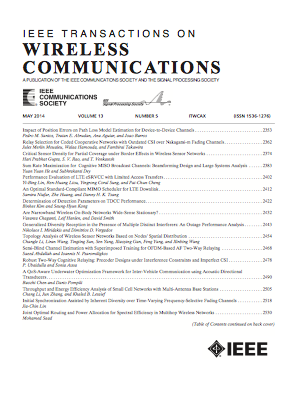RIS-Assisted ISAC Systems for Robust Secure Transmission With Imperfect Sense Estimation
IF 10.7
1区 计算机科学
Q1 ENGINEERING, ELECTRICAL & ELECTRONIC
引用次数: 0
Abstract
In this paper, we investigate reconfigurable intelligent surface (RIS)-assisted integrated sensing and communication (ISAC) systems for robust physical layer security (PLS) schemes. Traditionally, eavesdroppers (Eves) typically avoid interacting with the base station, making it challenging to obtain their relevant information, which limits the implementation of PLS. Fortunately, the sensing information obtained by ISAC can contribute to the design of PLS. Therefore, leveraging imperfect sensing estimation and employing dedicated radar signals as artificial noise, we formulate an RIS-assisted joint active and passive beamforming design problem to maximize the sum secrecy rate while satisfying the user’s quality of service constraints, the transmission power constraints, and the sensing signal strength requirements. To make the problem tractable, we first derive the bound for Eve’s channel state information uncertainty region based on security approximations. Subsequently, we employ the具有不完全感知估计的ris辅助ISAC系统的鲁棒安全传输
在本文中,我们研究了可重构智能表面(RIS)辅助集成传感和通信(ISAC)系统的鲁棒物理层安全(PLS)方案。传统上,窃听者通常避免与基站交互,难以获取其相关信息,这限制了PLS的实现。幸运的是,ISAC获得的传感信息可以为PLS的设计做出贡献。因此,利用不完善的传感估计,采用专用雷达信号作为人工噪声,在满足用户服务质量约束、传输功率约束和感知信号强度要求的前提下,提出了ris辅助下的联合主被动波束形成设计问题。为了使问题易于处理,我们首先基于安全近似导出了Eve信道状态信息不确定性区域的边界。随后,我们采用$\mathcal {S}$ -过程和符号确定性方法对无穷多个不等式进行变换。然后,我们利用一阶泰勒展开、二阶锥方法和连续凸逼近来解决非凸性问题,从而通过迭代算法获得有效的次优解。最后,仿真结果证明了感知功能在增强安全性方面的巨大潜力,以及所提出的鲁棒方案在灵活平衡通信和感知质量方面的有效性。
本文章由计算机程序翻译,如有差异,请以英文原文为准。
求助全文
约1分钟内获得全文
求助全文
来源期刊
CiteScore
18.60
自引率
10.60%
发文量
708
审稿时长
5.6 months
期刊介绍:
The IEEE Transactions on Wireless Communications is a prestigious publication that showcases cutting-edge advancements in wireless communications. It welcomes both theoretical and practical contributions in various areas. The scope of the Transactions encompasses a wide range of topics, including modulation and coding, detection and estimation, propagation and channel characterization, and diversity techniques. The journal also emphasizes the physical and link layer communication aspects of network architectures and protocols.
The journal is open to papers on specific topics or non-traditional topics related to specific application areas. This includes simulation tools and methodologies, orthogonal frequency division multiplexing, MIMO systems, and wireless over optical technologies.
Overall, the IEEE Transactions on Wireless Communications serves as a platform for high-quality manuscripts that push the boundaries of wireless communications and contribute to advancements in the field.

 求助内容:
求助内容: 应助结果提醒方式:
应助结果提醒方式:


